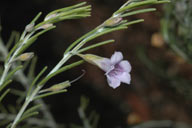In Flower This Week
A weekly news sheet prepared by a Gardens' volunteer.
Numbers before each plant refer to temporary IFTW labels in the gardens.
Numbers in square brackets [ ] refer to garden bed Sections. Plants in flower are in bold type.
View past issues of 'In Flower This Week'.
21 June 2013
Eremophila microtheca click for larger image |
There are many flowers to admire along this walk, including hakeas and grevilleas, and many other plants in bud. The bird calls are many and so enjoyable.
- Edging Banks Walk is Epacris impressa [Section 174], bright with its tube-shaped rich pink flowers.
- Just below is Epacris reclinata [Section 174], a small shrub clad with shorter tube-shaped flowers in another shade of pink.
- Almost opposite, a mint bush, Prostanthera phylicifolia [Section 210], is a large shrub falling over the rock wall. It is well‑covered with small mauve flowers.
- Following the road on the far side of the Rainforest view the picturesque Grevillea bipinnatifida ‘Jingle Bells’ [Section 124], standing upright and bearing many large pendulous terminal red flower spikes among its attractive foliage.
- Almost opposite is Banksia spinulosa [Section 126], a large dense shrub bright with its golden cylindrical upright flower spikes.
- At the end of this road, below the large branches of a brittle gum (Eucalyptus mannifera), is Thryptomene saxicola ‘Pink Lace’ [Section 10]. It is so pretty with tiny pink flowers covering the low shrub.
- Continue uphill where Correa ‘Canberra Bells’ [Section 119] bears bright red and cream bell-shaped flowers on the open shrub. It has been selected to commemorate Canberra’s Centenary, 1913-2013.
- Opposite is an emu bush, Eremophila maculata [Section 302], with yellow tubular flowers over the low open shrub.
- At the corner another emu bush, Eremophila microtheca [Section 302], is a tall shrub with tiny mauve bugle flowers amid its foliage.
- Continue along this road to the right, passing a hedge of Correa alba [Section 7]. These are dense shrubs with white star-shaped flowers amid the grey-green foliage.
- Later, among other shrubs, Grevillea epicroca [Section 25] is quite large and clad with many dusky pink buds but only a few dusky red spider flowers.
- Grevillea diminuta [Section 25] is a shrub with rust‑red flowers dangling from its branches.
- Around the corner is Stenocarpus sinuatus [Section 27], with almost concealed red-orange flower clusters among its lobed green leaves.
- Close by is Ivory Curl, Buckinghamia celsissima [Section 27], also an upright shrub but crowned with long cream flower sprays.
- Cross over the road to see Hakea cycloptera [Section 24], an open shrub clad with small lacy cream and white flowers. Then follow the Main Path to the next crossing.
- Take the next gravel road on the left (see map) to view Hakea scoparia [Section 22], with cream flower clusters surrounding the stems with long needle-like leaves.
- Follow this ‘returning’ road, passing Hakea orthorrhyncha var. filiformis [Section 21], with long angular branches along which small clusters of red flowers are attached.
- Before taking the next path to the right, view Hakea cristata [Section 23], an attractive dense shrub with small cream flower balls edging the branches between the prickly ovoid leaves.
- Edging the side path, Hakea bakeriana [Section 21] is a spreading shrub with pretty pink and cream open flower clusters and large fruits attached to the branches.
- Seen here also is Hakea suaveolens [Section 20] with cream lacy flowers along its long branches.
There are other hakeas, not yet flowering, in this area. Continue along this path finishing at the Rock Garden.
Barbara Daly
![Director of National Parks [logo]](../../../../images/dnp_90px.gif)







